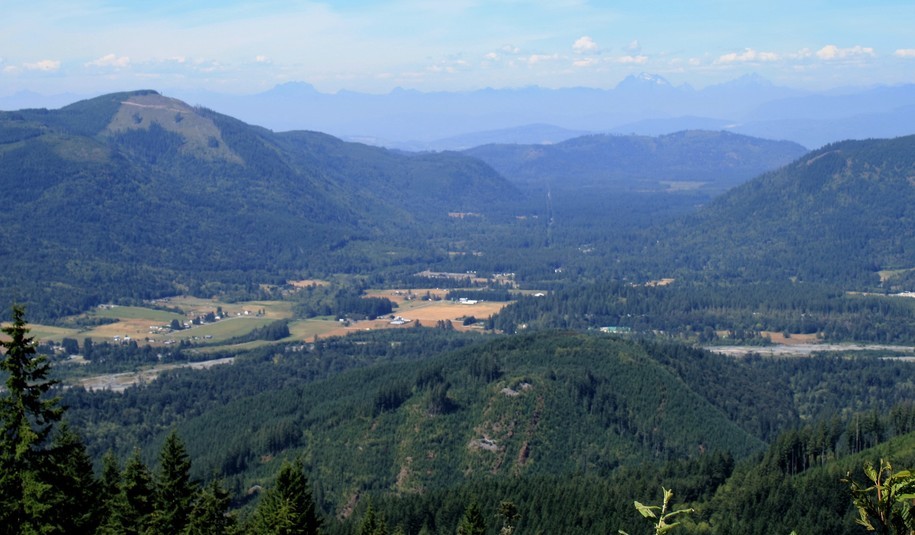

Nooksack River valley with the river running right to left in the mid-ground. Taken from Slide Mountain above Maple Creek Reach looking north toward British Columbia.
Fall 2016
Maple Creek Reach
Nooksack Valley, WA
This fall I participated in a celebration day to welcome back the salmon of Maple Creek Reach that brought over 100 people to its meadows and river beds. This event was sponsored by the Whatcom Land Trust to honor its supporters for the huge efforts given to preserving this scenic, once wild and pristine property and streams. Located in Whatcom County in the far northwest of the Lower 48, this event was co-sponsored by Nooksack Salmon Enhancement Association, the Lummi and Nooksack Tribes, and supported by numerous local businesses. The Trust restores and cares for over 20,000 acres of County land.
Maple Creek is a tributary of the North Fork of the Nooksack River and provides spawning grounds for all five species of Pacific Salmon and Steelhead Trout. Maple Creek meanders south from Silver Lake to where it joins the North Fork Nooksack River. Upstream the Nooksack is fed by icy waters, fresh off the glaciers from on and around Mt. Baker. After coming off the mountains the Nooksack flows down the valley across meadows where it is fed by smaller creeks such as Maple Creek which in turn meanders across the valley floor through stands of spruce, cedar, hemlock, poplar, and alder. Along its meander the creek is slowed and backed up by beaver dams and ponds. This slow moving water creates pools for trout and spawning redds for the returning salmon and steelhead.
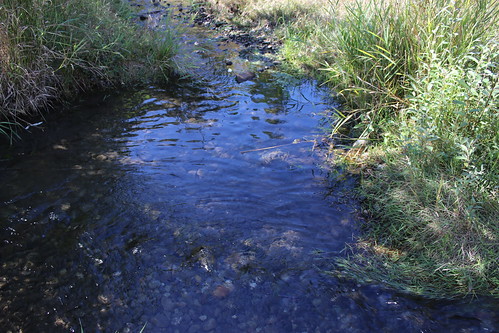
Clean, slow moving water, ideal of spawning redds.
Until only about 150 years ago, these lands were primal forests inhabited by the indigenous animals and, for the past 10,000 or so years, by Coast Salish peoples. When homesteaded by white men in the late 1800s, the land was logged for timber and cleared for cattle grazing and dairy farming. For much of this land, that era is over and now it is time to return this land to nature and protect it from further human destruction and development. Our goal now is to preserve it for posterity and to enable future generations to enjoy its beauty and bounty.
Our Tour of Maple Creek reach
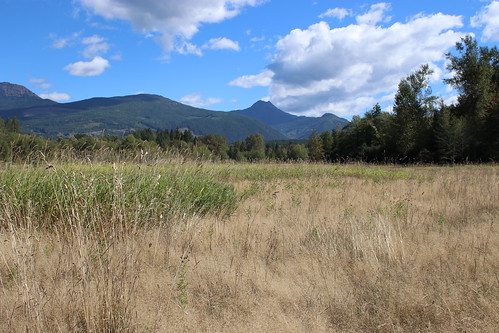
Former dairy grazing pasture, now being reclaimed, looking out to Church mountain in the distance
In addition to beavers, wild life abounds in this area populated with deer, elk, bear, cougar, eagles, voles, coyotes, frogs, salmon, and trout.
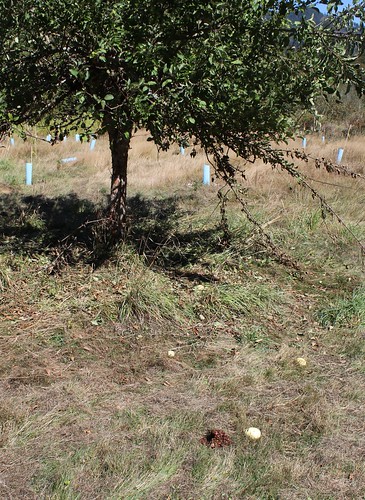
Various trees have been planted here over the years since it has been used as dairy land such as a grove of spruce. The first thing we all noticed was that these trees were relatively short but quite broad, growing outward rather than up as one might expect. Our guide explained that these trees had been attacked by a Spruce Bud Beetle that stopped growth upward but not outward.
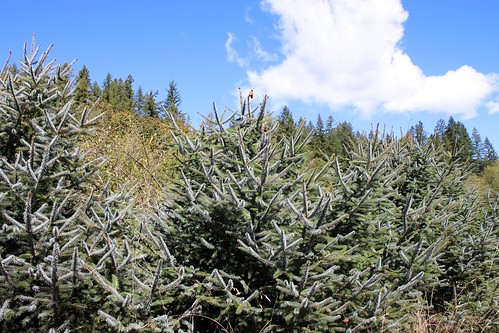
note the rusty bud at the top of the tree in the center
In looking into this further I found that there is a Spruce Budworm that does such things.
“What the budworms are doing is eating the new foliage, which eventually turns rusty brown,” she says. “They eat from the top down and the outside in. Most trees do survive and recover, though it may take decades.” Western spruce budworm (Choristoneura occidentalis) occurs naturally in Washington, Idaho, western Montana and Colorado.
The good news is that these spruce are otherwise quite healthy and will likely survive and eventually start growing up again.
Other restoration activities in the meadow included restoring some of the more natural hillocks. When logged, and then turned into a grazing meadow, everything was leveled out. Restoring some more natural topography to the terrain promotes more wetlands habitat for critters such as the Western Frog.

Returned to wet lands to support Western Frog
This Nooksack River Valley has been carved by meanders back and forth across the land over eons. Looking south from the valley floor we see Slide Mountain rising, part of the folded Chuckanut formation that is loaded with Eocene fossils.
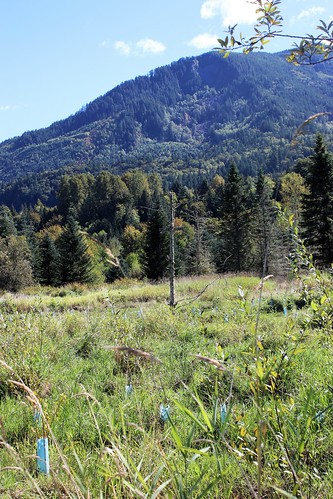
Note where the face has sloughed away on Slide Mountain in the distance.
The Nooksack River currently lies about 100 yards east of the meadow lands pictured above.The river has cut its way back and forth across the valley but has now run into bedrock at the foot of slide mountain.
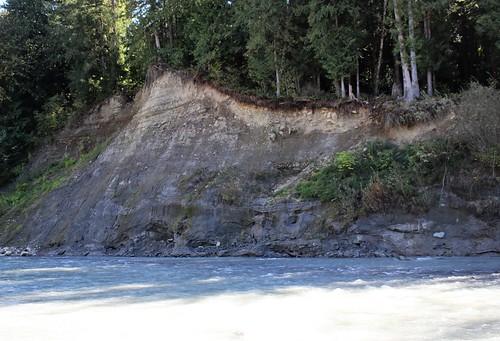
Bedrock of the Chuckanut Formation at river level impedes further eastward erosion.
When the river floods which is often with spring thaws and heavy rains, it overflows its current bed on the near side of the river. This entire valley has been at one time or another part of the river bed.
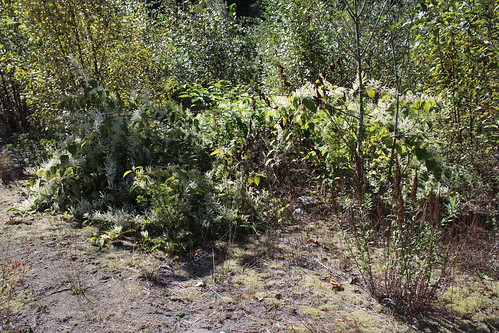
Occasional river bed now sporting Goatsbeard (Aruncus dioicusand ) and Pearly Everlasting (Anaphalis margaritacea)
On its course to meet the Nooksack River, Maple Creek works its way across the meadow and through thickets of poplar, vine maple, and alder which provide perfect cover and building materials for the beavers to build their dams. The dams in turn slow the water for young salmon smolts to grow and mature in preparation for their downstream voyage to the salt water estuaries.
This and other pools were teeming with fingerling salmon (smolts) still hanging around the beaver ponds from last year’s spawn.
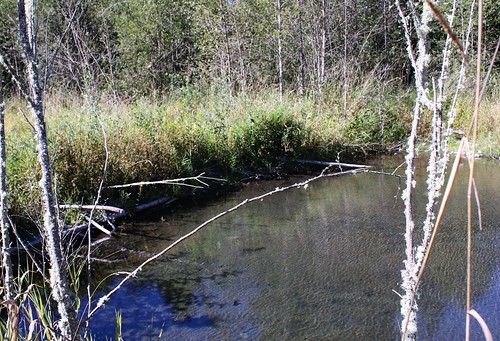
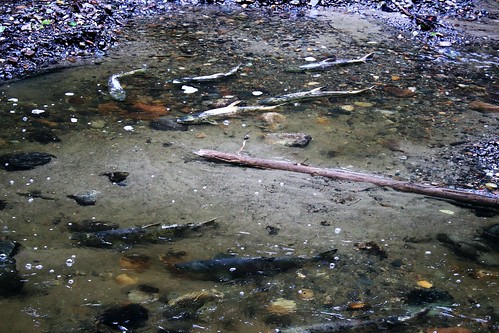
As is quite apparent, their bodies were deteriorating and their thrashing through rocks and logs of shallow streams had severely scarred them.

An American Dipper (see arrow) dipping for stray salmon roe. They populate the spawning streams this time of year. Note the two spent salmon on the right and one above, having given their all for the next generation.
After touring the creek, meadow and river, we assembled for dinner and an interesting convocation and program to thank all of the volunteers who have supported the Land Trust and made this and other restorations possible.
The highlight was an invocation by Anthony Hillaire, an elder of the Lummi Nation who related the age-old story of the Salmon Woman. He related how she and her children saved the Lummi Tribe from starvation. After many years of Salmon Woman and her children supplying salmon for the tribe, the people grew complacent and some even made fun of her. Feeling disrespected she took her children and left the streams. As the elders saw what happened they chose one of them to pursue her and he lured her back, praising her and apologizing for those who disrespected her. To this day the Lummi nation and others, perform their ceremony of praise each spring to welcome back the salmon and to show their continuing appreciation for the bounty that Salmon Woman and her children bring each year.
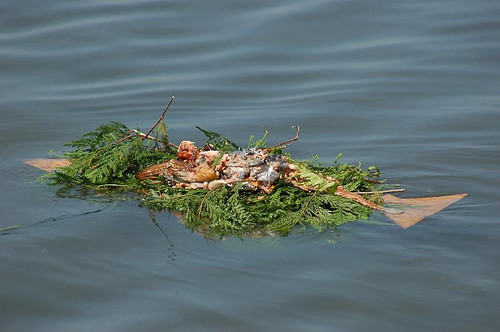
First salmon of the spring returned to water on cedar boughs in honor of Salmon Woman. Attribution: Flickr common
The tribes are also very involved with the Trust and other restoration efforts in maintaining and restoring salmon habitat. The Trust’s philosophy in managing Maple Creek and their other 20,000 acres of trust lands is to eschew a prescriptive approach to restoration that would try to put everything back the way it was, as best we could tell.
Rather they:
“ … focus on restoring habitat-forming processes and then trust those processes to do what they’ve successfully done for Millennia.” (The Steward, v.24, Spring 16)
That is, they are restoring the broad conditions conducive to letting nature do its own thing as it has forever.
These restoration efforts are sorely needed along with much more appreciation, thanks and even pleading to Salmon Woman to keep these mystical swimmers coming back and replenishing themselves. But alas, it is up to us.
Importance of Habitat Restoration:
In recent years most (but not all) salmon returns have been shy here in the Salish Sea as their critical habitat is being lost and seriously threaten. Among the threats are stream and sea pollution from poisonous run off. For example, recently trace amounts of drugs, including Prozac and cocaine have been found in salmon from the Salish Sea.
Diminished estuaries and eel grass beds for maturing smolt acclimating to salt water are being lost due to shoreline development and industry. Also the ever present increasingly warmer waters threaten salmon as temperatures creep upward to record highs. And the loss of forage fish which salmon rely on such as smelt and herring are diminished as their habitat too is lost.
It is sad enough for us to be losing our sacred (and tasty) salmon, but worse is that their presence in the Salish Sea is also critical for the health and survival of our endangered Resident Orca population who depend on them for their sustenance. Our local resident Orca gave us hope this past year gaining nine new babies. However, three have died recently, as has one of the younger mothers and another young female, all likely of malnutrition.

Orca Mother and calf trailing
This is one classic example of the cascading consequences of our careless and selfish actions upon the web of life.
Without habitat restorations upstream from the Salish Sea like Maple Creek Reach, we will lose both salmon and orca. Native Americans and First Nations populations will lose important parts of their thousands-year old culture and sustenance for many. The salmon are canaries in the coal mine for us and the planet.
As a more positive aside, it is of interest that our local tribes are supplying salmon to the Standing Rock protesters in North Dakota. These salmon come from the Salish Sea and more directly from Nooksack River described here and some are likely to be from maple Creek. Hence the web of life broadens.


Hello Moosekateers,
Here is a little post that describes some environmental restoration of our salmon habitat on the Salish Sea. Good is being done in the world and god knows we all need some good news these days. I hope you enjoy a little bit our part of the country
Thanks RonK……I love the photo of the offering to Salmon Woman. It’s important to remember, respect, and support the healing power of nature.
Thanks for your comment PP. Give nature a chance.
Thanks, RonK! There is so much natural beauty in your state! I hope there will always be people interested in restoring and protecting the environment.